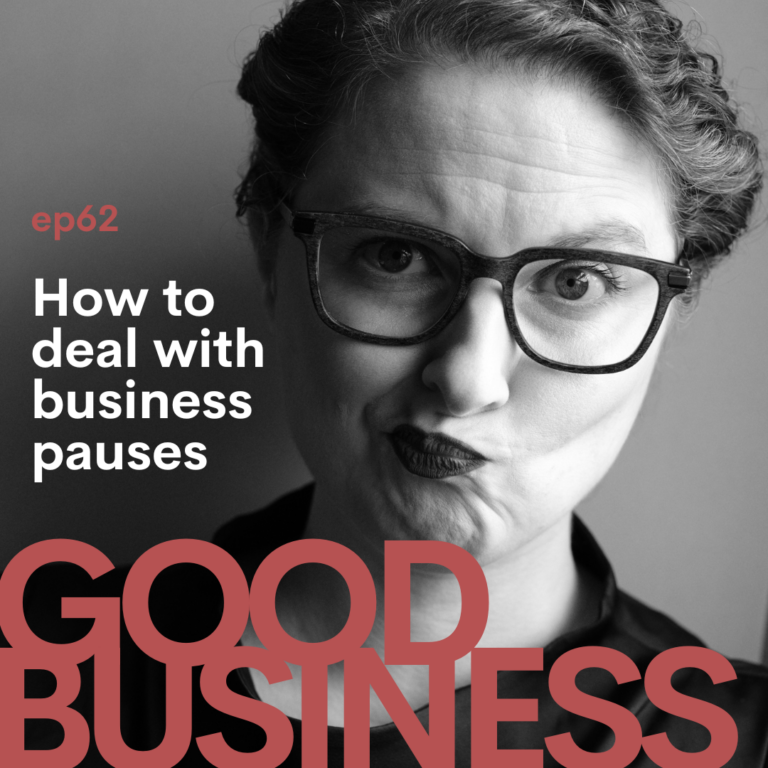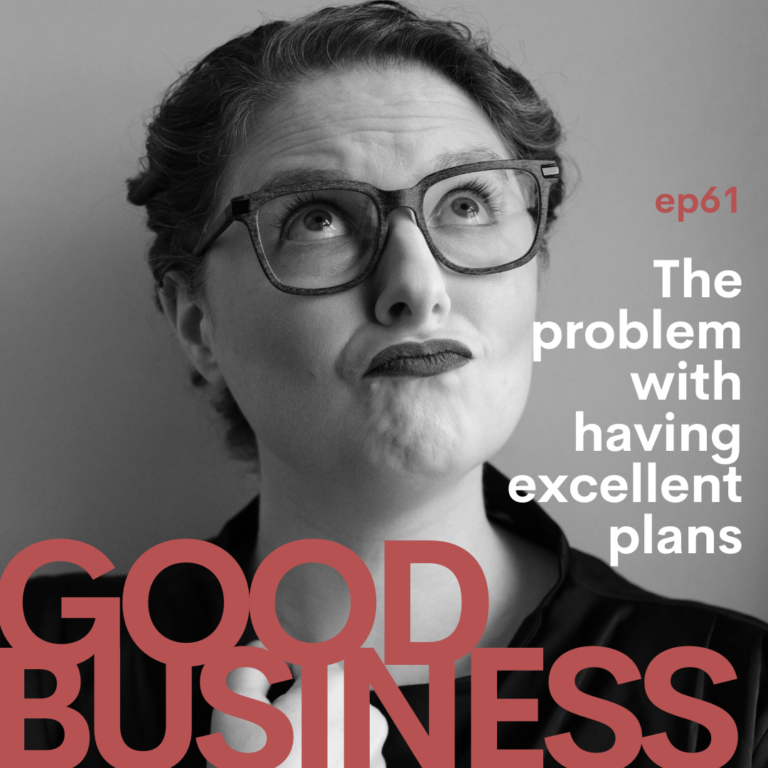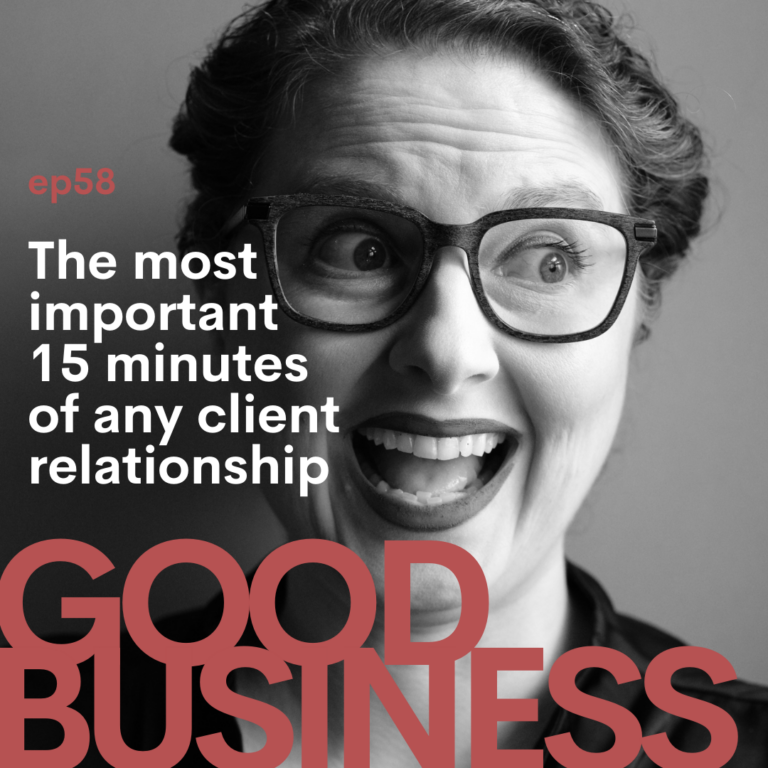This episode is the second in a series on how to do amazing consults and why it matters. The answer is not just “because it’s how you get money.” We’re using consults as a basic template. But the structural process that I’m going to lay out for you can be applied to anything from doing a job interview to interviewing a new assistant to starting any kind of relationship.
Today we’re talking about the middle. What do you do in the middle of a consult or an interview?
Episode Transcript:
Welcome back to The Good Business Podcast. I’m your host, Illana Burk. And today I’d like to welcome you to part two of our How To Do An Amazing Consult three-part series.
In our last episode, we talked about how to do really solid, empathetic openers, how to put people at ease, how to put yourself at ease, why it matters, how to deploy empathy in a functional way.
And today, we’re talking about the middle. What do you do in the middle of a consult or an interview? Mostly we’re talking about consults, but this really can apply to interviewing someone, if you’re being interviewed… these are the things to look for in a good leader and any kind of a peer-based relationship building.
What do you do in the middle? Let’s say you’ve got about an hour. I’m using that as a template because that’s how I do my consults. The middle part is always the messy part. What questions do you need to ask people? What are you listening for? What are you looking for in that meaty part in the center?
Are you just letting the conversation take you wherever it goes? Are you really strategically asking very specific questions? Do you have a list of questions that you ask everybody? If so, where did those come from? What are you actually looking for? And how do you know? This is really critical.
Especially when you’re starting out or if you haven’t done a lot of these or if you’ve been doing it for a really long time, but you’ve been doing it really unconsciously — meaning, you’re not really paying that close attention. And you’ve just been doing it the same way forever and ever and ever. But you’re not really paying attention to what am I doing? How am I doing it? Why is this important? Are you just following someone else’s template?
If any of those conditions are at play here, this is the episode for you.
So the middle part is where I offer the very best of me. And here’s why. People hire you for what you can do for them.
If you’re interviewing someone else, you’re hiring them to see if they can make your life easier. No matter what, there’s a symbiosis at play, no matter what side of that power dynamic equation you’re on. You’re both kicking each other’s tires. So the meaty part in the middle has to be where you show off the best of yourself. If you’re asking the questions, you should be asking questions that feel like a gift to the other person. You should be asking questions that are thought-provoking, and not selfishly motivated. It’s not about gathering information for yourself. It’s about seeing how that person thinks.
Helping them to get something new from their own experience. To maybe mine for something that is a little deeper than what they thought they might say. That’s how you get real information from someone. If you’re interviewing someone and you ask stock questions, like, you know, tell me about a time when you were really successful in your last job, they’re going to have stock answers.
But if you ask something that’s a little bit deeper, like, “What are the parts of your role that make you feel most successful?” You’re going to get an entirely different set of answers that’s going to be far more raw and far more true. And they’re going to have the benefit of feeling like they were asked something by someone who cares about them. Who cares about their experience over their outcomes. That’s how you get better outcomes is by empowering someone to have the very best experience doing the work that they most want to do. Or even that they’re not that excited about, if you’re doing mundane stuff. Empowering them to feel like they’re allowed to get joy from it is an amazing way to set the tone for the kind of work that you want to get from people.
Now, back to the consult side of this, right. If you’re doing a consult where it’s important that you can produce results, don’t be shy about calling it like you see it in the meat of a call. Ask a couple of good questions. Get permission to offer them some advice if you’re a coach or you’re a purveyor of some kind. And then tell them exactly what you think they should do. Go out on that limb. Take that risk. Tell them that’s what you’re doing.
I often tell people on consults, Hey, I’m going to call it like I see it. So you can get a taste for what working with me is like because that’s exactly what I do. I shoot from the hip. I call it like, I see it. And it’s coming from a place of a tremendous amount of experience.
I will tell you if I don’t understand what you’re talking about, or I don’t have anything to contribute. I’ll let you know that too. And that will tell us both something. Whether or not, we’re a good fit. Whether or not I feel excited about learning the things that I need to learn in order to get to a place where I can give you good advice.
No matter what though, I’m going to start with really probative, really deep questions that challenge their assumptions. I want to know why they make the decisions that they make. I want to know what’s underneath. I’m not interested in what their social media strategy is right out the gate. That stuff can come later.
I want to know why they chose to create videos instead of a podcast. I want to know what was underneath the conscious choices they made about their branding. I want to know what is most important about their next step to them. And why they love what they do or don’t. What gets them up in the morning? What makes them feel enthusiastic? What are they most embarrassed about in their business that they feel kind of sheepish about? What do they stumble over, over and over again?
Give me something to work with. Ask hard questions because then you’re going to get thought-provoking answers. For them. And for you. One of the greatest things that you can do for another human being is to ask them a question that gets them thinking in a direction that they’ve never thought before.
That feels like a gift. If you can do that on a consult. They are yours forever. It’s not a manipulation. It’s offering something freely that costs you nothing. It’s showing them that you care more about their experience than, about selling them something. That has to be true. By the way. I’m making the assumption that that’s true for anybody listening.
Okay. So once you’ve done that. Keep your eye on the clock. Make sure you’re honoring the timing that you said you would. And always leave time for the logistics questions. I typically leave about 15 minutes at the end of every call. I don’t have a lot of logistics to go over. I don’t have a lot of options to present.
If you have more options, make sure you leave more time. Always remember as well, that if you have more to say at the end of the call where you’re going over, logistics, leave extra time, not just because you’re going to need more explaining time, but because they’re going to need more emotional energy in order to process that information.
Especially, if you just ask them a bunch of deep and probative questions, their head’s going to be in that space. And not in that closing wrap-up logistics space. So make sure you’re conscientious about the pacing of the dynamic at play. Right? If you have a full hour, that can feel like a lot. If you’re a super-intense person like I am.
Be really clear and objective about who you are and how people experience those moments with you so that you’re leaving plenty of space. I tend to pace my calls with buffer conversation in between little brief, funny stories, to help with the pacing, to help give people an emotional break, a mental break in between big, deep questions and talking about money and logistics. It really just helps people kind of ease in and out to the various stages of a good consult.
I hope that all made sense to everybody. And I look forward to talking you through how to close really really well in a way of it leaves people wanting more on both sides. I look forward to seeing you all then. Bye.
More Episodes
How to deal with business pauses | GB62
In the fast-paced world of entrepreneurship, taking a break can often feel like a foreign concept. The constant pressure to grow, scale, and make a bigger impact can make prioritizing personal well-being and life outside of work...
The problem with most excellent plans | GB61
Ever plan an amazing business move but hit a roadblock? This episode tackles the "pothole" of poor planning for solopreneurs. Learn how to "right-size" your strategy based on your resources and set yourself up for sustainable...
When to stick and when to bail | GB60
Feeling stuck in a business project that’s not taking off? This episode’s for you! We explore the often-overlooked skill of quitting and guide you through 4 key questions to help you decide when to persevere or let go. Learn to identify your true motivations, navigate self-doubt, and make choices that align with your goals and well-being. Listen to discover when to stick and when to bail!
You might not need a VA after all | GB59
Overwhelmed business owner? Stop! Hiring a VA might not be the answer. Learn how to ID expert vs. VA tasks & hire the right person for the job (without becoming a “shitty boss”). Listen in and get bonus tips in the show notes!
The most important 15 minutes of any client relationship | GB58
In this episode of the Good Business Podcast, we dive into the critical 15 minutes that can make or break a client relationship. Want to know why these first few minutes are so crucial, what should be included, and how to adjust...
Want better clients? Make more mistakes. | GB57
Today’s topic is mistakes in business. Why? We all make them. Good business involves managing both good and bad situations effectively, with elegance, education, confidence. This skill is often overlooked. Let’s explore common...






